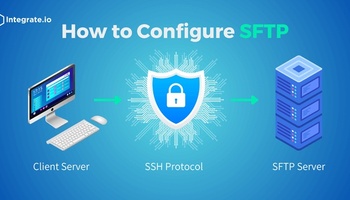Flat files are files that contain a representation of a database (aptly named flat file databases), usually in plain text with no markup. CSV files, which separate data fields using comma delimiters, are one common and well-known type of flat file; other types include XML and JSON.
Thanks to their simple architecture and lightweight footprint, flat files are a popular choice for representing and storing information. For example, you can export information that doesn’t need to be stored in multiple database tables as a flat file and import it into a target data warehouse or data lake.
However, using FTP (File Transfer Protocol) to transfer flat files presents multiple security issues. Below, we’ll go over the concerns with FTP for flat files, as well as 5 tips to improve data security for your flat file databases.
What’s Wrong with FTP for Flat Files?
Data transfers frequently involve FTP communication protocol to transfer files between servers and clients connected to the same network. FTP has several benefits, including the ability to transfer large files and the ability to resume interrupted transfers.
However, FTP comes with one big problem for transferring flat files: it’s not a secure protocol. For example, usernames and passwords are in plain text, and the data transferred is not encrypted. This makes FTP vulnerable to malicious techniques such as packet sniffing, spoofing attacks, and brute force attacks. If you’re handling data that is sensitive, confidential or contains personally identifiable information, standard FTP is not an acceptable method of transferring flat files.
FTP for Flat Files Tip #1: FTP Alternatives
Perhaps the most obvious solution for transferring flat files is to use a secure alternative to FTP. Some of your options include:
- HTTPS, which extends the HTTP protocol with SSL/TLS for encryption and authentication.
- A cloud storage service such as Dropbox, Google Cloud Storage, or Microsoft OneDrive.
- Virtual data rooms (VDRs), which are cloud repositories for securely storing and sharing sensitive documents.
In the next two sections, we’ll discuss two popular FTP alternatives in more detail: SFTP and FTPS.
FTP for Flat Files Tip #2: SFTP
SFTP (SSH File Transfer Protocol) is a file transfer protocol for securely transferring, accessing, and managing files on a remote computer. As the name suggests, SFTP uses SSH, a cryptographic protocol for connections between servers and client machines. However, SFTP is not just FTP using SSH; it’s a new and distinct protocol in its own right.
SSH encryption protects files and data sent using SFTP while they are in transit. Any malicious actor eavesdropping on the connection cannot understand the contents of the data without the decryption key.
The increased security of SFTP makes it preferable to FTP in most cases. In particular, SFTP can comply with industry data security regulations such as HIPAA, PCI DSS, and GDPR.
Related Reading: How to Use SFTP to Securely Transfer Files
FTP for Flat Files Tip #3: FTPS
FTPS is an extension to FTP that contains support for the TLS cryptographic protocol. With FTPS, users can perform functions including secured file access, file transfer, and file management over any reliable data stream. So what’s the difference between SFTP and FTPS?
- As mentioned above, SFTP is a separate protocol from FTP, whereas FTPS extends FTP to use TLS.
- SFTP authenticates connections using either a username and password or an SSH key. FTPS authenticates connections using a username, password, and SSL certificate.
- SFTP may be easier to implement than FTPS: it requires only a single port number to pass through a firewall, whereas FTPS requires multiple port numbers.
- FTPS can be slightly faster than SFTP.
FTP for Flat Files Tip #4: Data Encryption
In addition to using a secure protocol, encrypting the flat-file itself can help further protect your data while in transit between the server and the client. Data encryption involves multiple steps: first encrypting the data before transmission, then authenticating the client and server endpoints, and finally decrypting it once it arrives at its destination.
FTP for Flat Files Tip #5: IP Whitelists and Blacklists
Last but not least, IP whitelists and blacklists can be an effective technique for reducing the likelihood of malicious actors eavesdropping on your FTP file transfers. IP whitelists allow only a specified set of IP addresses to access the system, whereas blacklists restrict specific IP addresses or address ranges.
How Integrate.io Can Help with FTP Transfers
Worried about data security for your flat file transfers over FTP? Integrate.io can help. We include support for the SFTP secure file transfer protocol. Check out our article on creating an SFTP connection in Integrate.io to learn more.
With a user-friendly drag-and-drop interface and support for more than 100 integrations, Integrate.io's powerful ETL platform can help organizations of all sizes and industries with their data integration needs. Integrate.io makes it easy to build robust, production-ready data pipelines to your cloud data warehouse. To find out more, schedule a call with our team of data integration experts, or sign up to start your 14-day pilot of the Integrate.io platform.










